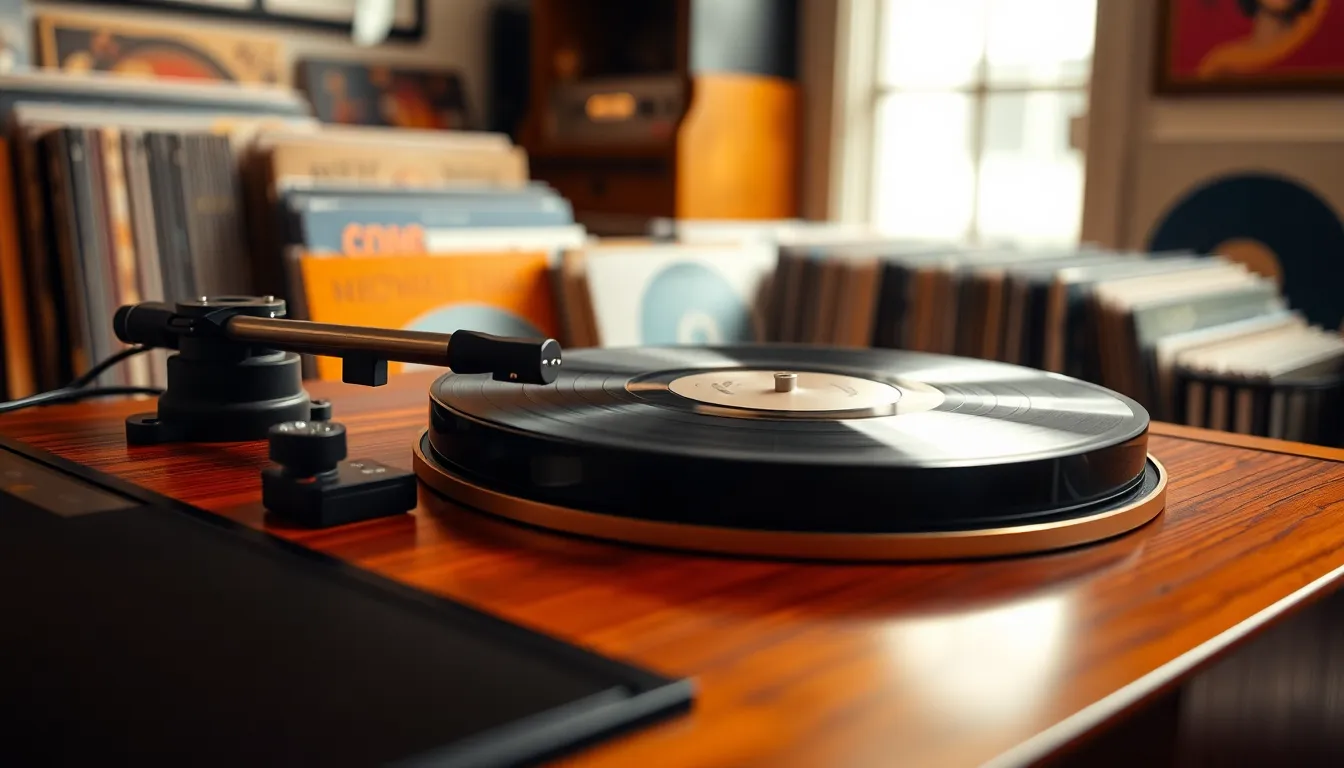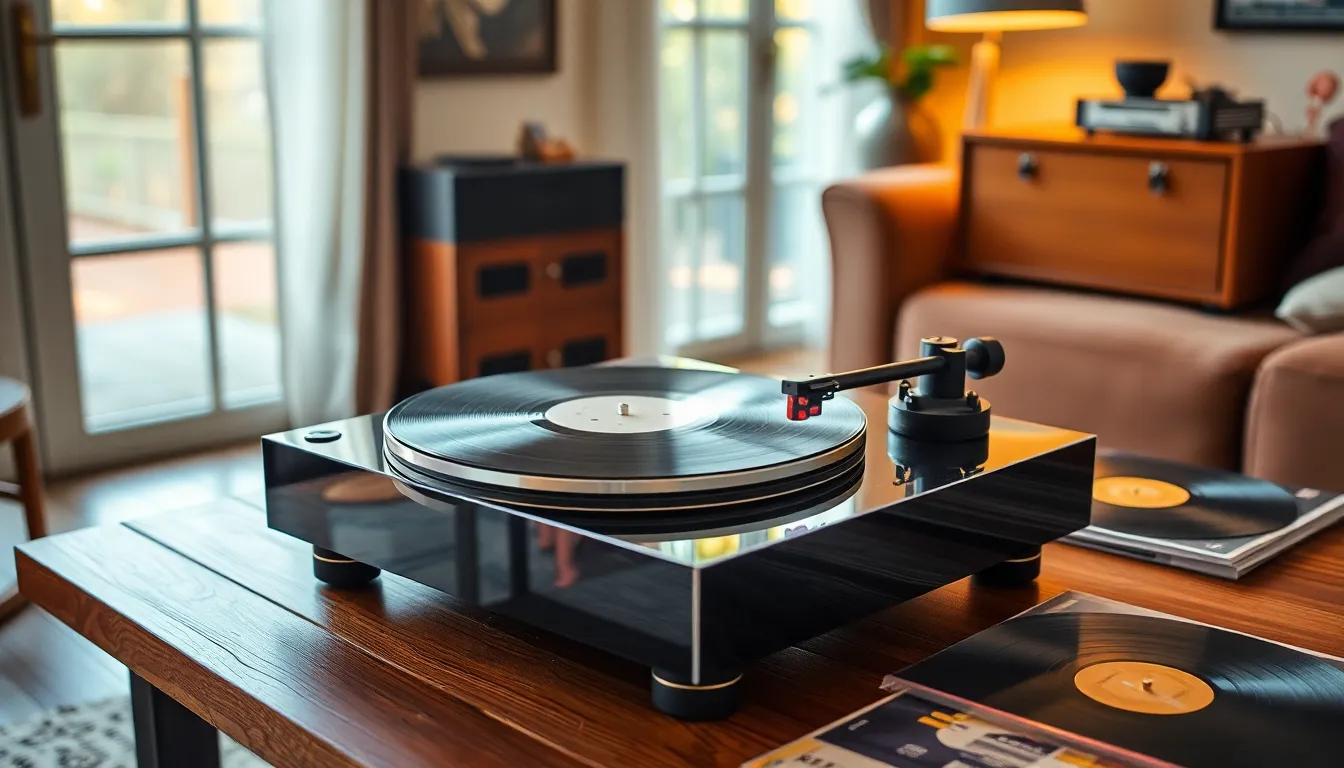In the age of digital music, record players have made a striking comeback, captivating audiophiles and casual listeners alike. There’s something uniquely satisfying about the crackle of vinyl and the warmth of analog sound that streaming services just can’t replicate. For those diving into the world of vinyl, understanding record player equipment is essential to achieving that perfect listening experience.
From turntables to cartridges and speakers, each component plays a crucial role in delivering high-quality sound. Whether one is a seasoned collector or a newcomer exploring the charm of vinyl, knowing how to choose the right equipment can transform any music session into a rich auditory journey. With the right gear, anyone can unlock the full potential of their favorite records.
Table of Contents
ToggleOverview of Record Player Equipment
Record player equipment plays a crucial role in delivering an optimal listening experience. Essential components include turntables, cartridges, speakers, receivers, and accessories. Each element contributes to sound quality and overall enjoyment.
Turntables
Turntables serve as the foundation of a record player setup. They consist of a platter that spins the vinyl record and a tonearm that holds the cartridge. High-quality turntables feature adjustable speed settings for both 33 1/3 and 45 RPM records. A well-constructed turntable minimizes vibration and resonance, ensuring clearer sound reproduction.
Cartridges
Cartridges are vital for converting the grooves of a vinyl record into electronic signals. Moving magnet (MM) and moving coil (MC) cartridges are two primary types. MM cartridges tend to be more affordable, while MC cartridges typically deliver superior sound quality. Selecting the right cartridge impacts fidelity and overall performance.
Speakers
Speakers amplify the audio output from the turntable setup. Passive speakers require a separate amplifier, while active speakers contain built-in amplifiers for convenience. Quality speakers enhance clarity and depth, allowing listeners to appreciate the nuances of the music. It’s important to match speakers with the power ratings of the amplifier for optimal performance.
Receivers
Receivers act as the central hub for audio connections. They manage input from the turntable while routing audio to speakers. Some receivers include built-in phono preamps, improving sound quality and amplifying the signal. Choosing a receiver with adequate power and features accommodates various setups and listening preferences.
Accessories
Accessories like isolation pads and cleaning supplies enhance record player performance. Isolation pads reduce vibrations from surfaces, improving sound quality. Record cleaning kits maintain the cleanliness of records, crucial for preserving sound clarity and longevity. Investing in quality accessories can significantly impact the listening experience.
Understanding record player equipment allows music enthusiasts to tailor their setups, leading to a richer, more enjoyable listening experience. Each component’s compatibility and quality contribute to how well one can appreciate the warmth and detail of vinyl records.
Types of Record Players

Different types of record players cater to various preferences and listening styles. Understanding these differences can enhance the enjoyment of vinyl records.
Belt-Drive Vs. Direct-Drive
Belt-drive turntables utilize a rubber belt connecting the motor to the platter. This design minimizes motor noise, resulting in warmer sound quality. Audiophiles often prefer belt-drive models for their superior acoustic performance and isolation from vibrations.
Direct-drive turntables feature a motor directly linked to the platter. They provide quick start-up times and consistent speed, making them popular among DJs. While they may transmit some motor noise, advancements in technology have improved sound quality in modern direct-drive systems.
Manual Vs. Automatic Record Players
Manual record players require users to initiate and cease playback by placing and lifting the tonearm. This hands-on approach offers enthusiasts greater control over the listening experience, allowing for precise adjustments.
Automatic record players simplify the process by automatically placing and lifting the tonearm. Users benefit from convenience, especially in multi-album sessions. However, some purists argue that this added ease can reduce the tactile experience of vinyl listening.
Essential Components of Record Player Equipment
Understanding the essential components of record player equipment enhances the listening experience and allows music enthusiasts to make informed choices. Key components include the turntable, cartridge and stylus, and tonearm.
Turntable
The turntable serves as the foundation of the equipment setup. It rotates the vinyl record, translating the grooves into audio signals. Turntables can be classified into two main types: belt-drive and direct-drive. Belt-drive turntables utilize a rubber belt that connects the motor to the platter, resulting in reduced vibrations and a warmer sound, appealing to audiophiles. Direct-drive models feature the motor directly beneath the platter, providing quicker start-up times and stable speeds, making them ideal for DJs.
Cartridge and Stylus
The cartridge is essential for converting the mechanical energy of the stylus into electrical signals. Two primary types of cartridges exist: moving magnet (MM) and moving coil (MC). MM cartridges are generally more affordable and offer a balanced sound, making them suitable for casual listeners. MC cartridges, however, provide higher fidelity and finer details, appealing to serious audiophiles. The stylus, often referred to as the needle, plays a crucial role in tracking the grooves of the record; its shape and material can significantly influence audio quality, with conical and elliptical shapes being common choices.
Tonearm
The tonearm supports the cartridge and guides the stylus along the record’s surface. It plays a critical role in tracking accuracy and sound quality. Tonearms vary in design, with types including straight and S-shaped. Straight tonearms generally improve tracking and reduce distortion at the outer grooves, while S-shaped tonearms facilitate better alignment of the cartridge with the record. Adjustable counterweight systems allow users to fine-tune tracking force, ensuring optimal performance and minimizing record wear.
Features to Consider When Choosing Record Player Equipment
Selecting the right record player equipment involves examining several critical features. Understanding these aspects enhances the listening experience by ensuring optimal audio performance and durability.
Sound Quality
Sound quality ranks as a primary consideration. Evaluate the components that significantly impact audio fidelity, such as the turntable’s design and the cartridge type. Moving coil (MC) cartridges typically deliver superior sound but come with a higher price tag. Moving magnet (MM) cartridges offer good quality at a lower cost. Assess the stylus shape as well; elliptical stylie tend to extract more detail than conical options. The overall material and design of the turntable also affect sound characteristics, with heavier platters minimizing vibrations and resonance.
Build Quality
Build quality plays an essential role in durability and performance. Examine the materials used in construction, as higher-quality materials can reduce unwanted vibrations. Heavy and sturdy constructions often provide enhanced stability and better sound reproduction. Additionally, check for features such as reinforced chassis, isolation feet, and precision-engineered tonearms, which all contribute to improved sound and longevity. A solid build ensures that the record player can withstand regular use without compromising audio quality over time.
Connectivity Options
Connectivity options greatly influence user experience. Explore various output types, including RCA outputs for connection to speakers or receivers. Some models offer USB connectivity, enabling users to digitize vinyl collections easily. Look for Bluetooth capabilities for wireless audio streaming, allowing compatibility with modern audio systems. Ensure the record player has appropriate phono preamps, whether built-in or external, to accommodate different setups, providing flexibility for both casual listeners and audiophiles alike.
Investing in quality record player equipment can transform the listening experience. With the right turntable cartridge and speakers, music lovers can unlock the rich tones and textures that vinyl offers. Whether someone is a seasoned collector or just starting out exploring the world of records, understanding the nuances of each component is essential.
Choosing between belt-drive and direct-drive systems or deciding on manual versus automatic players can greatly influence enjoyment. Accessories also play a vital role in maintaining sound clarity and performance. By carefully selecting equipment and considering personal preferences, anyone can create a setup that enhances their appreciation for vinyl music. Embracing this unique format not only brings joy but also connects listeners to the artistry behind their favorite albums.




